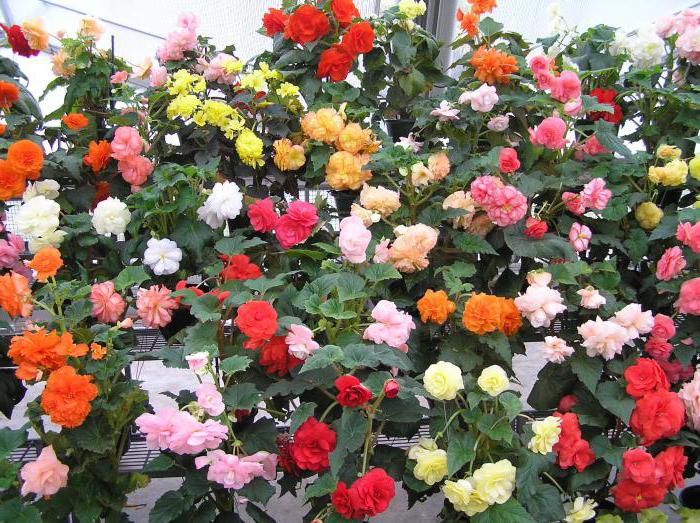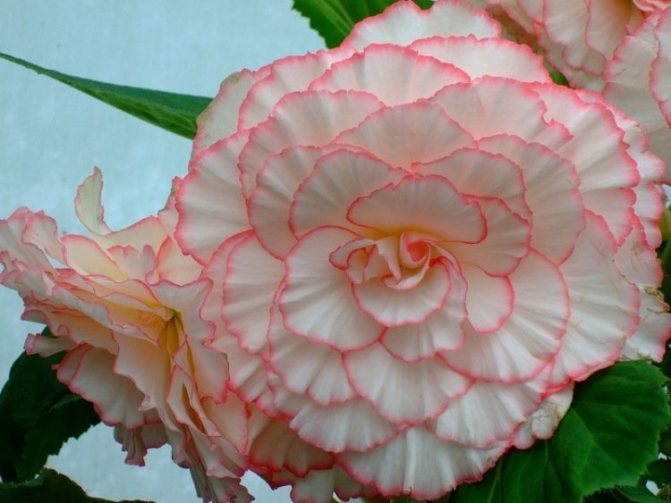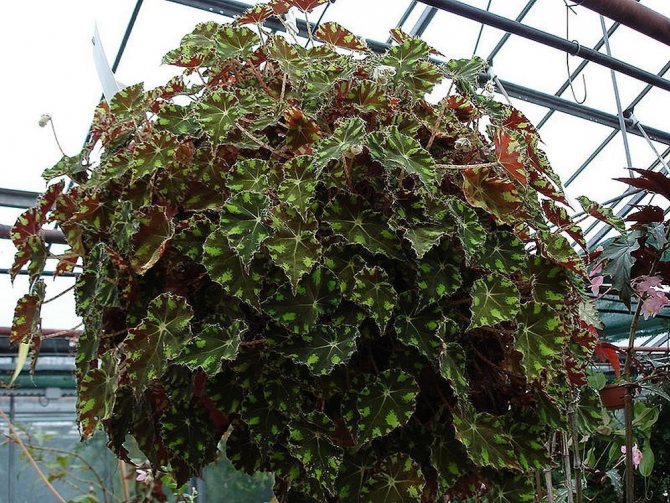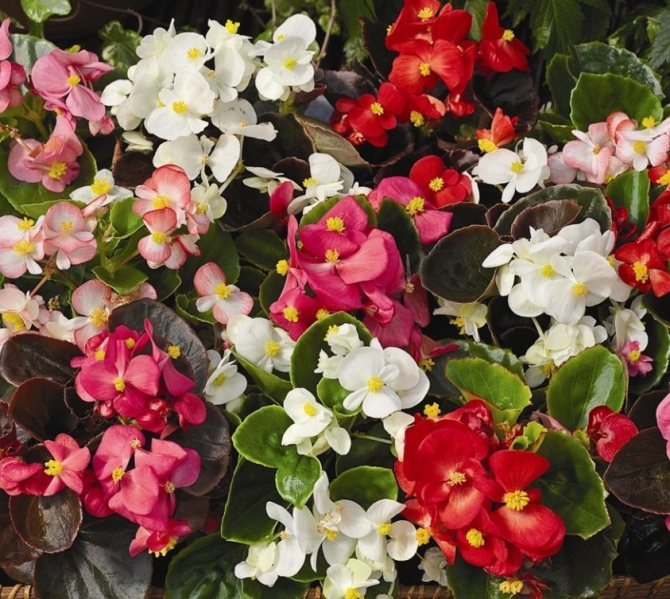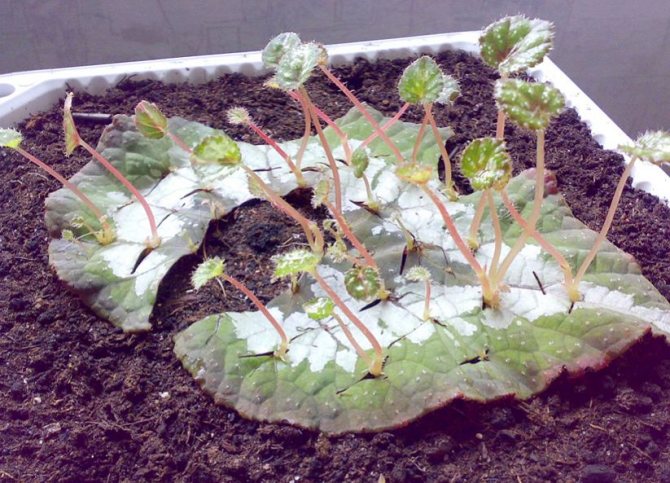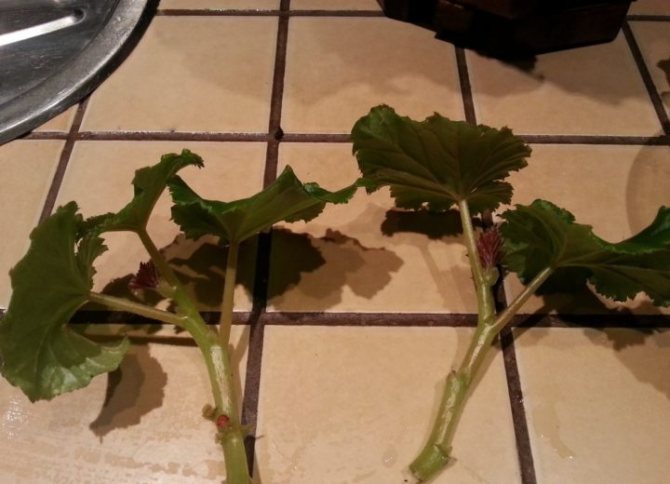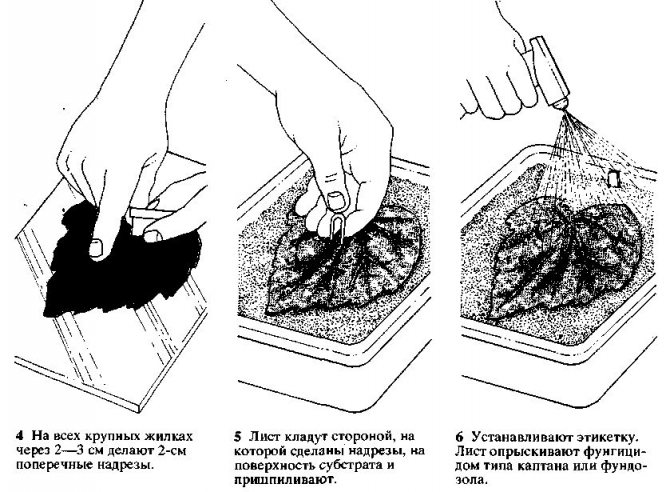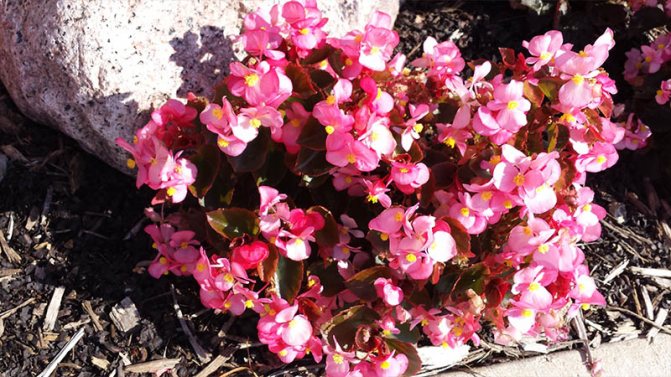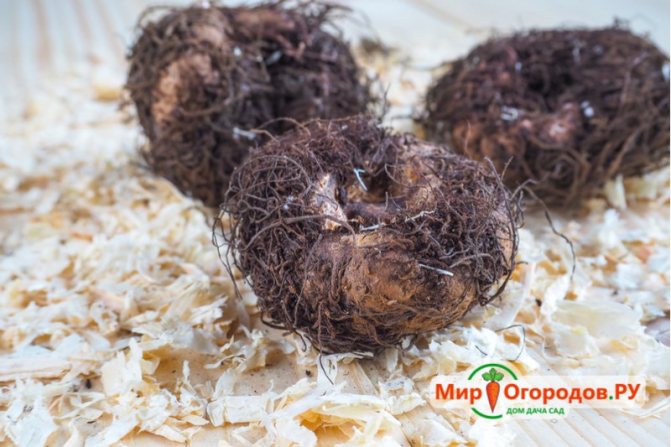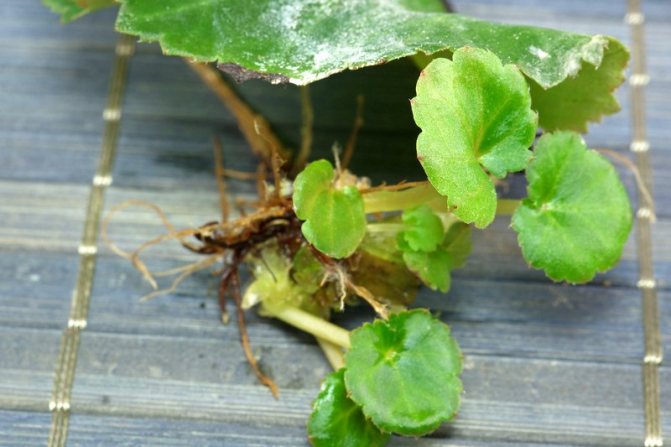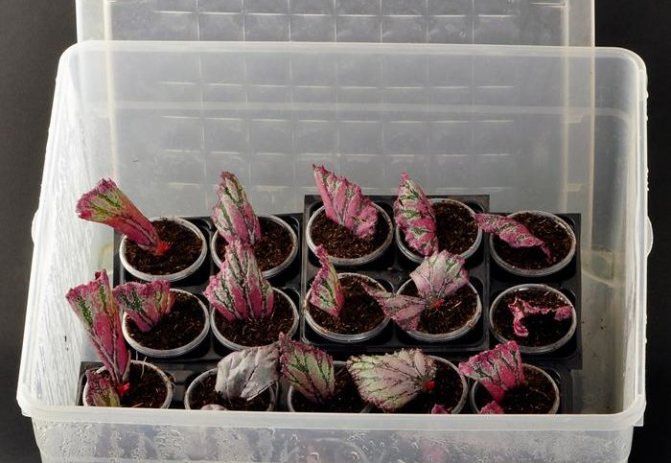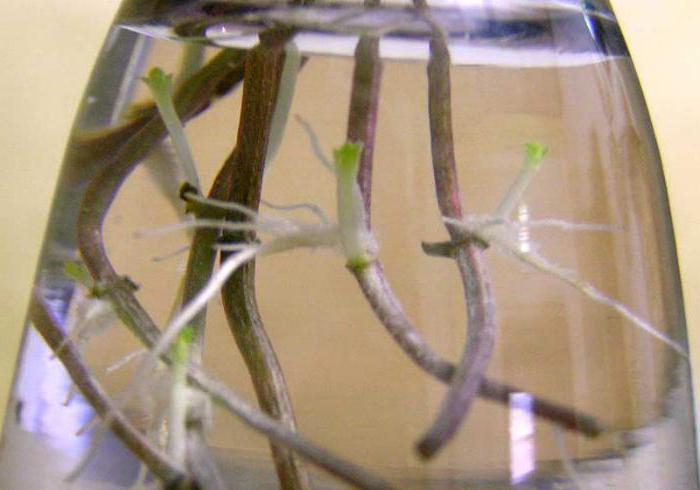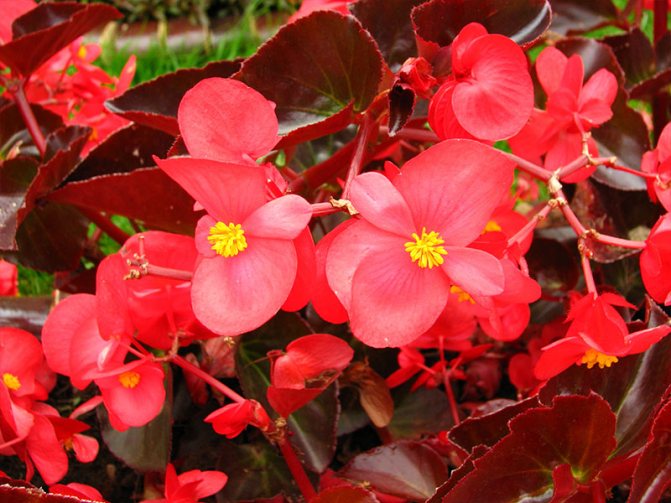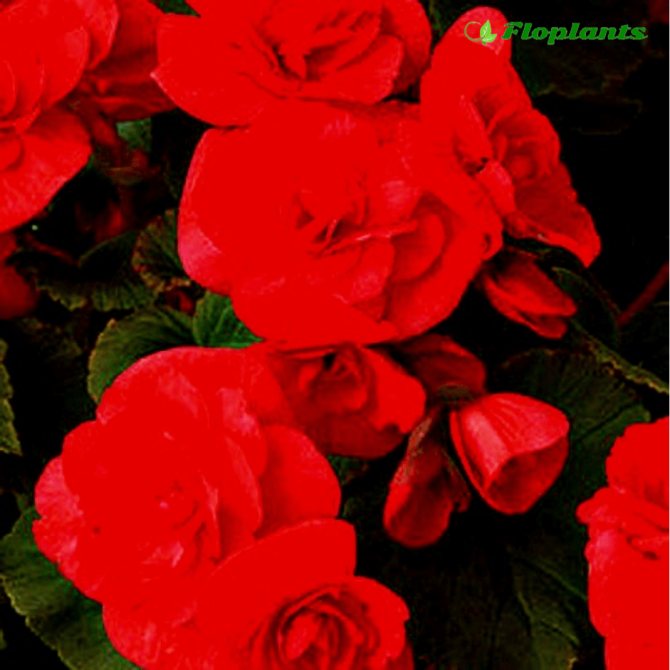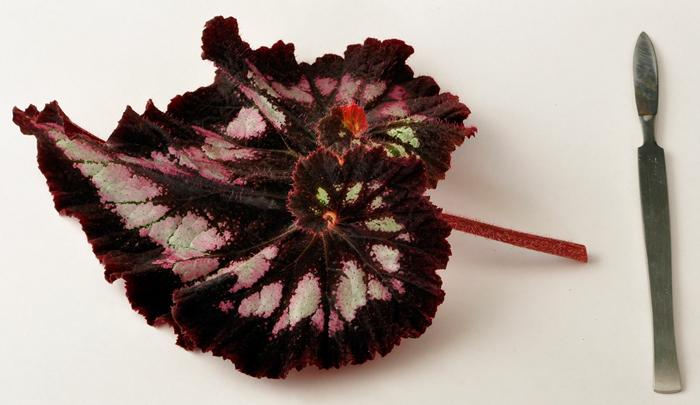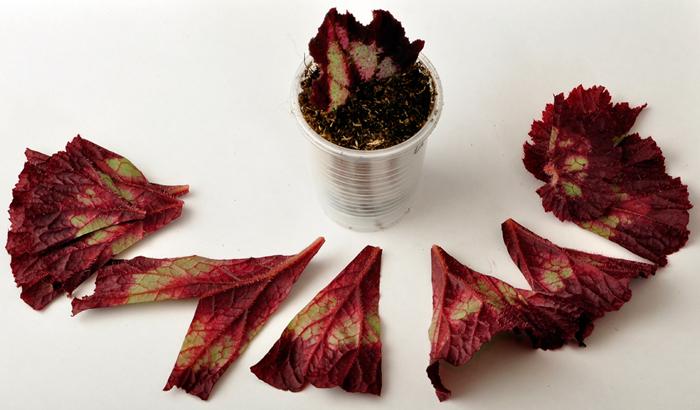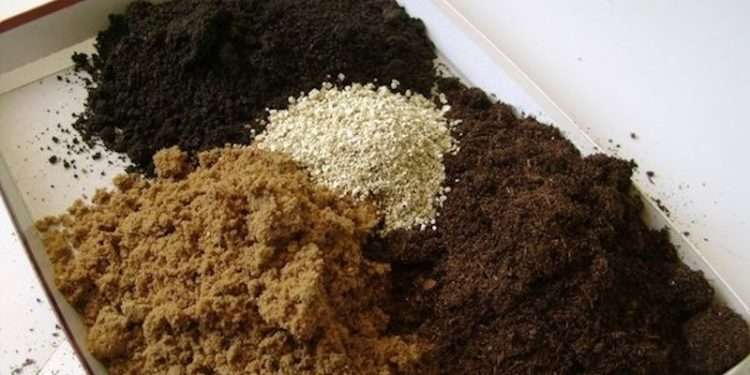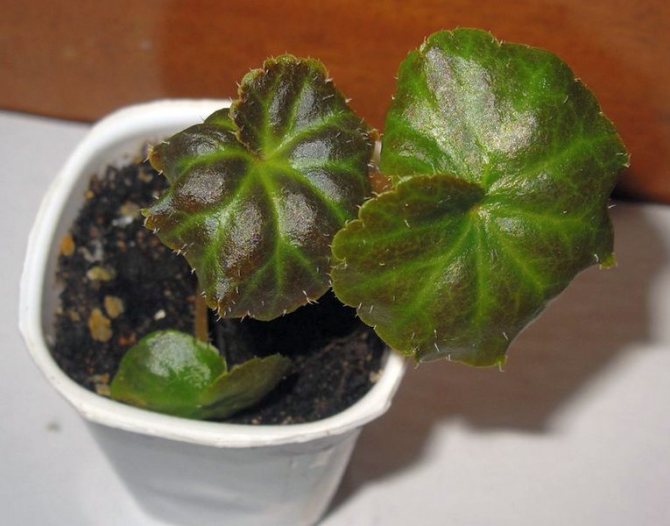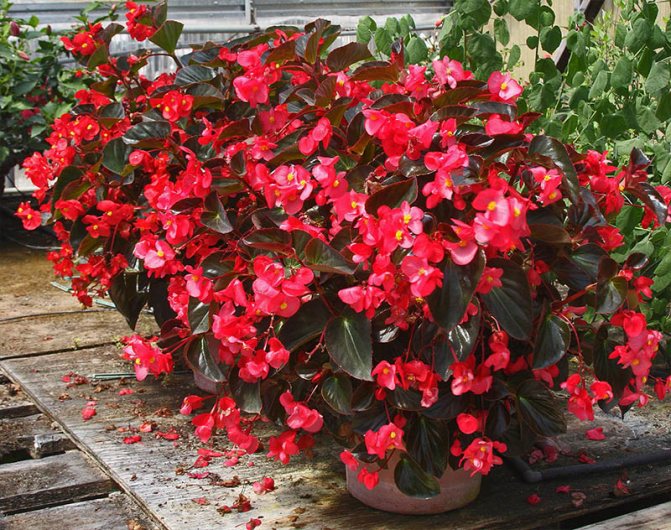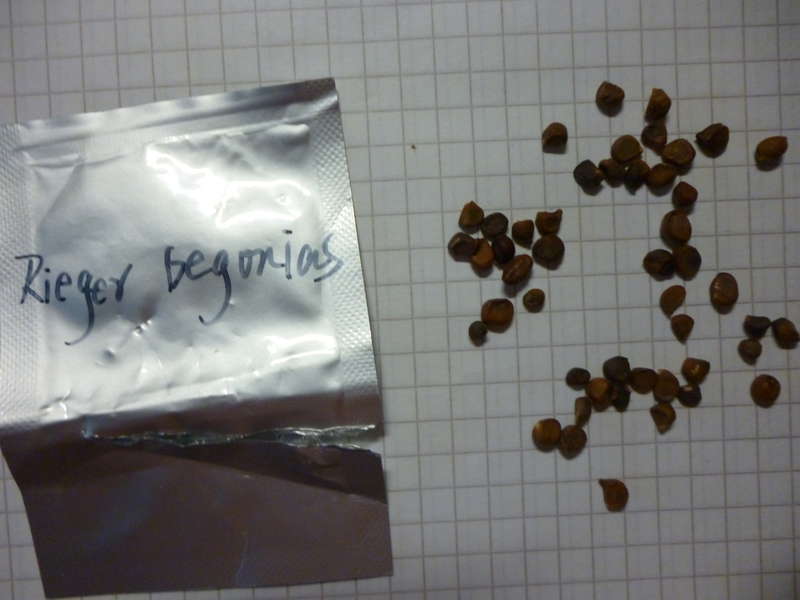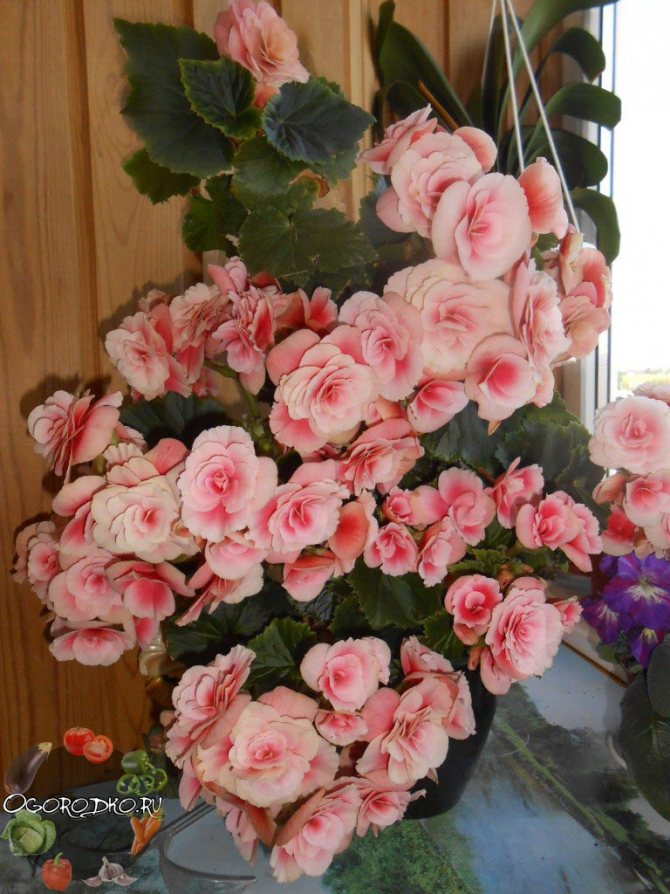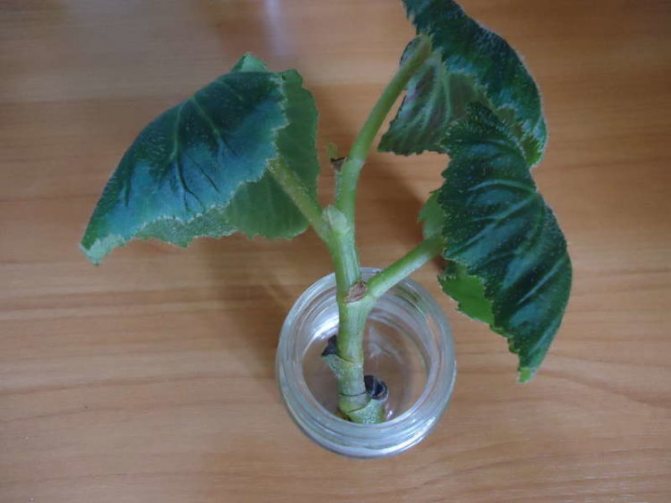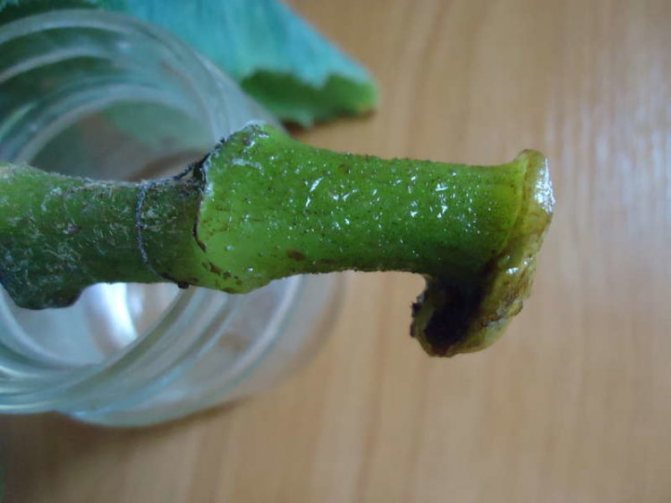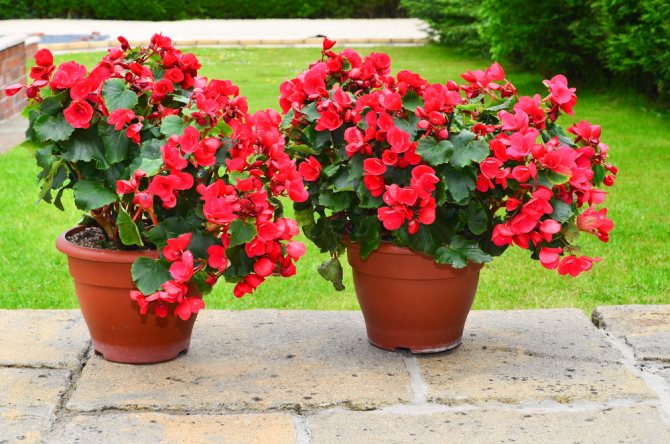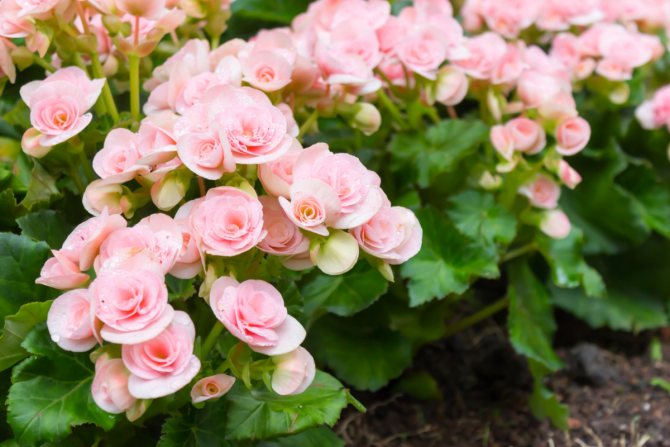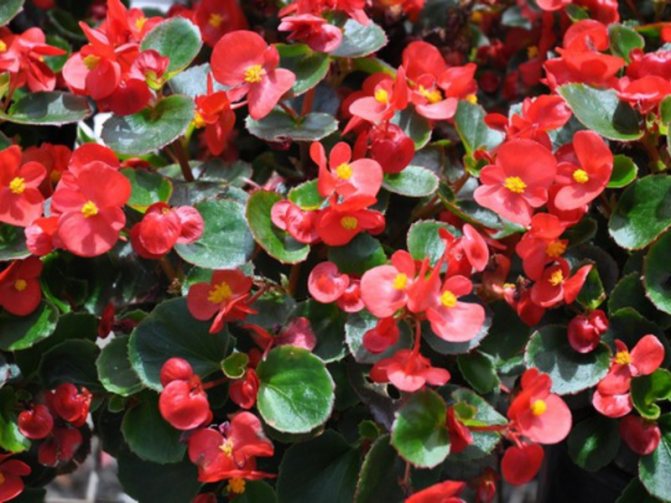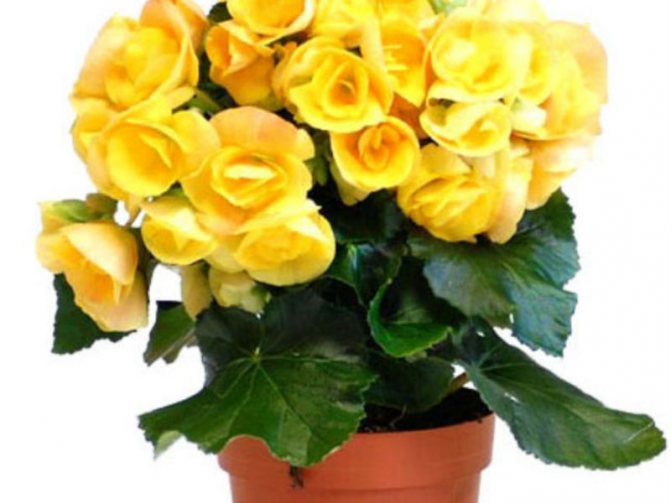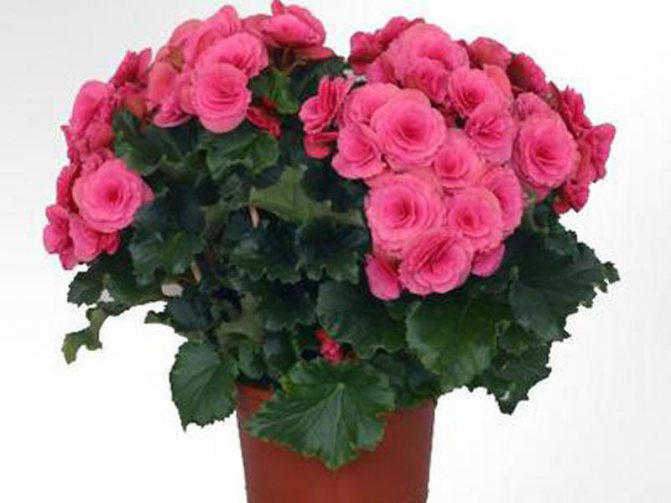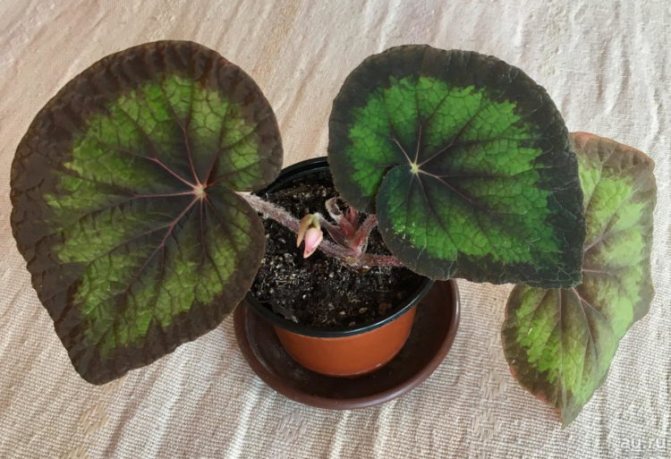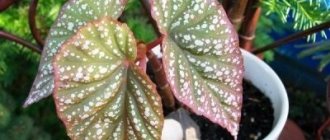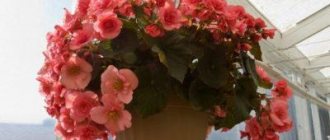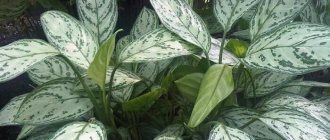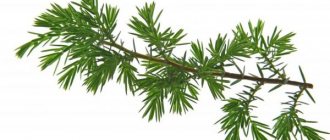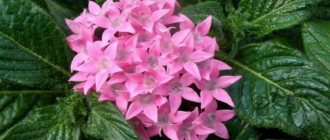Description of the plant
Begonia is a real treasure for a florist... Among its species, you can find both flowering and deciduous ornamental plants. The variety is so wide that it is difficult to describe begonia as a separate plant.
Teardrop-shaped, rounded, elongated, similar to a maple leaf or heart, leaves of deciduous-decorative begonia amaze with their forms. In addition, they have a very diverse color: red, black-red, silvery, speckled, with a complex pattern, pink-green, purple and gray leaves.
Beautifully flowering species of begonias amaze with no less variety... During the flowering period, the bushes are densely covered with simple and pink complex flowers. Yellow, white, cream, orange, red, pink, and purple petals can be found among the diverse species of this plant.
Reference. Since the 17th century, this plant has been actively used in indoor and garden floriculture. In nature, there are more than 1000 species, the geographic homeland of which are Africa, Asia, India.
Reproduction by fragments of a leaf
Some gardeners prefer to grow begonias from leaf fragments. To do this, take a sharp scalpel or a clerical knife and divide the plate into 7-10 fragments of arbitrary shape, but so that a large vein remains on each, and preferably 2-3. Sometimes the leaf is divided across into several parts, so that a main vein remains on each fragment. The edges of the sheet are cut off. Be sure to use only a sharp tool. If you take a dull knife, it will crumple and deform the plate.
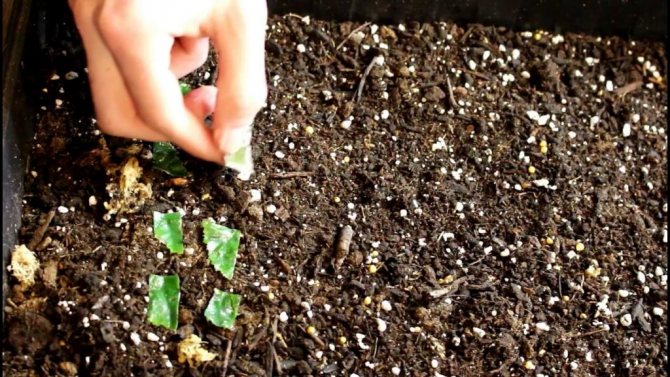
Each fragment obtained has the potential to grow a new begonia. Fragments are rooted only in sand or loose soil, with a large admixture of peat and sand.
For planting, you need to take a large flat pot (high pallet), pour soil into it and moisten it with a spray bottle. Then spread the pieces of leaf at a short distance from each other and cover the container with foil in order to create a greenhouse. Some gardeners prefer to plant the planting material vertically - with thick veins down.
Seedlings are aired 1-2 times a day, gradually increasing the time spent outdoors. It is important to keep the substrate moist at all times.


How to propagate - ways
Among such an abundance of species, indeed, every flower lover will find a plant he likes, most likely not even one. Therefore, consider the options how you can propagate begonia at home:
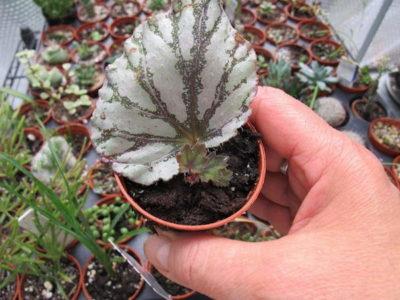

Seeds all flowering (not to be confused with flowering) species reproduce. The process is long and complicated. It is quite possible to plant and grow indoor begonia in this way, but at the initial stage you will have to take care of it like a baby.- Dividing tubers tuberous begonias can be propagated.
- Leaf cuttings and leaf fragments... Yes, begonia is extremely prone to reproduction, so even a piece of a leaf is capable of producing offspring.
- Stem cuttings, that is, the method of grafting, familiar to all flower growers. This method gives a quick result, with a fairly simple technology.The easiest and fastest propagation method, which is suitable for almost any type of this plant.
Popular varieties
There are several types of begonias that are commonly grown:
- Royal, or rex. The most popular of the decorative deciduous. A plant with large (20 × 30 cm) leaves of a heart-shaped shape. They can be smooth or pubescent, in a variety of colors. Propagation of royal begonia by cuttings (stem and leaf) is possible. Popular varieties - Silver Greenhart (with silvery leaves), Cartagena (dark, twisted leaves, with pink or plum, silvery spots), Hallelujah, Chocolite Cream, Evening Glow (with a raspberry border on the leaves), Charm, November cold, Black Fang ( leaves are red-black, with yellow veins twisted in a double helix).
- Coral. A semi-shrub that, with good care at home, reaches one meter. The trunk is mostly bare, the leaves are large, oval, green, with whitish specks. The flowers are collected in elongated inflorescences of a beautiful coral color. Popular varieties - President Carnot, Lucerne.
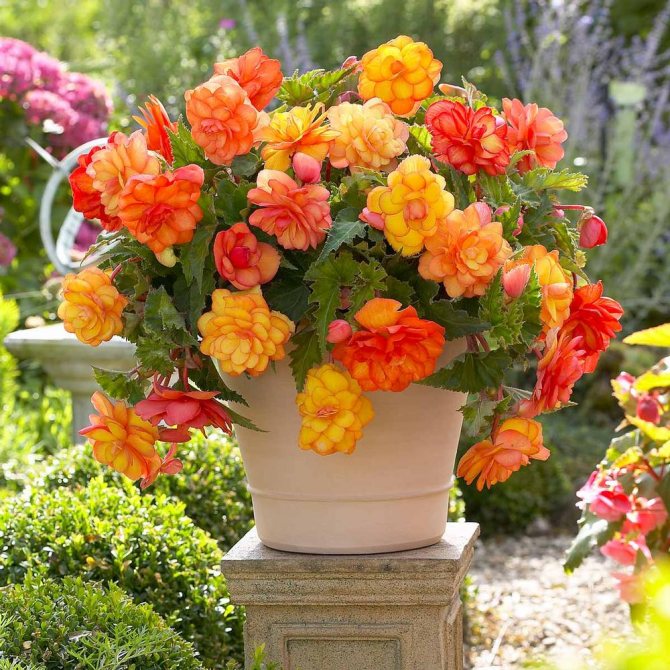

- Eternal blooming. The most beautiful representative of the genus begonias. It is a short, 50-60 cm, bush with small leaves and flowers, collected in large inflorescences. Flowers usually die off quickly, but they are immediately replaced by new ones. In this case, the cycle can last for many months, and if you provide good lighting, then the bushes will bloom in winter. Most often, ever-flowering begonia is propagated by a cuttings. We'll tell you a little later how to root it correctly. Popular varieties are Ambergris, Carmen, Orange, Bicol, Fuchsividnaya.
- Elatir. A beautifully flowering ornamental plant without stems and shoots. At home, it is propagated mainly by leaves. Representatives - Louise, Rose, Renaissance.
- Ampelnaya. Varieties with creeping shoots and a wide variety of flowers - simple, double and semi-double. Propagation of ampelous begonia by cuttings is the most logical option. Other methods will be more time consuming. Popular varieties are Christie, Gail, Katy, Roxana.
General rules for grafting
In addition to the step-by-step instructions for the process, there are rules and conditions that must be taken into account in order to get a good result:
- When and how is the best way to graft? For indoor specimens, the best time is the month of March. Plants planted in spring develop in harmony with natural biorhythms. If your begonia spends the summer outdoors, you can cut the cuttings in the summer.
- The temperature required for successful rooting is 20-25 degrees. This is very important, in an insufficiently warm atmosphere, roots are unlikely to form.
- Humidity also plays an important role in the cutting process. Therefore, for a guaranteed result, the cuttings are made in a mini-greenhouse, simply by covering them with a plastic bag or a cut plastic bottle. In no case should the cuttings touch the walls of the greenhouse. The shelter must be removed daily for ventilation.
- The soil for rooting cuttings should be light moisture and breathable. You can mix peat and perlite, or peat and sand.
- A large capacity is not needed, because immediately after the appearance of small roots, the plant will be transplanted to its permanent place of residence. A regular plastic cup will do.
- Lighting for cuttings is as necessary as for mature plants. Therefore, during the rooting period, the cuttings should be in a well-lit place.
- Only absolutely healthy and strong shoots are used for cuttings.
Preparation of planting material
How to plant a begonia stalk? Initially, it is necessary to select a good planting material. Cuttings can be taken from the top of the bush or from the side shoots. Usually you can get a lot of planting material when pruning a bush. Begonias are considered very tenacious, so they actually need only one growth point (leaf or bud on a branch) for rooting.But it is better if there are 3-4 of them. Therefore, cuttings are made 15-20 cm each, with an oblique cut at the bottom. The bottom sheet is cut off completely, a third is cut off at the top so that the leaf plates do not draw on a lot of life's juices.
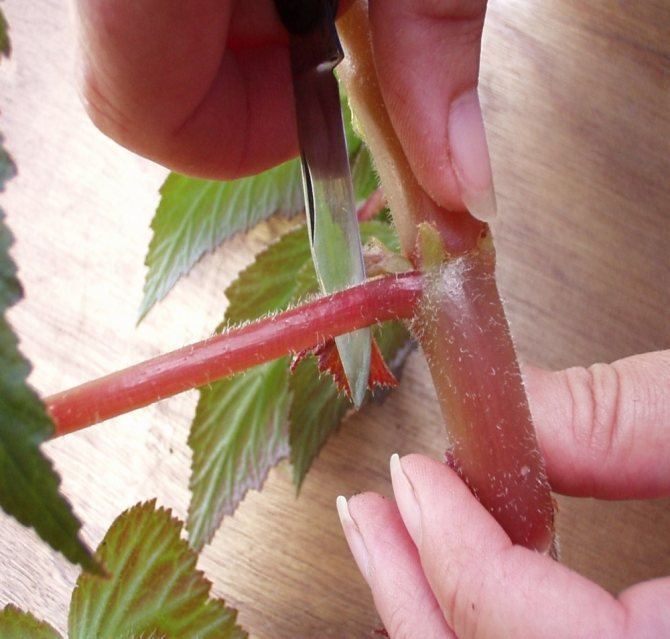

For leaf cuttings, strong, without signs of disease, yellowness, wilting, leaves with developed veins are selected.
There are two main ways to root a begonia by cutting - in water or in soil. They are considered to be equivalent. But when seated in water, the cuttings must be harvested with a margin, since some of them will necessarily disappear. In addition, it is believed that when planted directly into the ground, healthier and stronger plants are obtained.


Landing


Pour a mixture of perlite (sand) and peat into a plastic cup, spill it, wait until the moisture is evenly distributed.- The stalk is dipped in water, it is also possible to use stimulants such as root. Then they stick it into the ground by 2-3 cm, lightly press the soil with your fingers.
- Then cover the container with a jar, glass or bag. Place a mini-greenhouse with a shank in a lighted warm place.
Reproduction by a cut sheet
Leaf cuttings of begonias can be started by cutting the plate along the main veins. This method allows you to get a lot of seedlings from one leaf. The place of each cut will become a growth point, roots will stretch from it into the ground.
To obtain sprouts, the leaf is laid and pressed to the ground - with twigs, stones, brackets, etc. It is necessary that it does not in any way move.
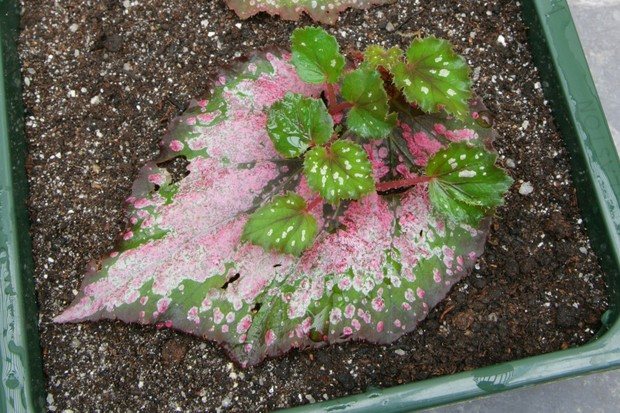

As necessary, the soil is moistened, but not excessively, otherwise the leaf will simply rot. After 3-4 weeks, several young begonias will appear from one plate. As soon as they are expanded by 2-3 sheets, they can be moved to separate flowerpots.
How to root in water?
If for some reason, for example, a bad experience, rooting in the ground scares you, then begonia may well root in water.
- For rooting, you need to take a transparent container, pour clean water at room temperature there, place the cuttings in it and wait. Only the bare part of the stem should be in the water, not the leaves.
- Keep soaked cuttings in a warm and bright place, and you also need to make sure that they do not start to rot. You do not need to put a whole bunch of cuttings in one glass, it is better that they do not touch each other.
- As soon as the plant gives roots of 1-2 cm, the shoot must be transplanted into the ground for permanent residence.
Advice. You can find soil for begonias in specialized stores, but you can prepare it yourself. The main thing is that it should be light, fertile and have a slightly acidic or neutral reaction.
How does begonia bloom?
What to do after begonia has faded?
After the plant has pleased you with lush flowering, it, without touching the roots and stems, definitely worth drying... We put it in a dark place for a month so that all the nutrients from the stems and roots go into the tuber. We dig it out 15 days after the upper part of the begonia that is on the surface has finally died out.
Do begonia need to be pruned after flowering?
After the flowering stage is completed, the plant needs pruning. At the same time, the stems are cut... This is necessary so that the flower gains strength and nutrients and has the opportunity to thank its mistress in the future with a magnificent and fragrant bouquet of terry begonia inflorescences.
How to properly prune a plant after flowering?
The procedure is carried out only with a sharp knife, but in no case, not with scissors, which can injure a delicate flower.
In order to avoid rotting and speed up the healing process, we treat the cut sites with wood ash or crushed coal.
After pruning begonias, we reduce watering before the start of active growth... If the lateral shoots have grown to 12 cm, we stop their tops, which will awaken the lateral buds.
Next, we monitor the state of the plant, removing knocked-out or dry branches and leaves, shoots directed into the begonias.
Photo of the rooting process
Check out the photo of rooting begonia:
Seeds
The seed method of reproduction is rather lengthy and tedious, therefore it is most often used in breeding work. However, it has a right to exist.
It is optimal to sow in January. In this case, young plants will get stronger by autumn and will be able to safely survive the winter. For breeding, it is convenient to use plastic containers with a lid or other containers that can be covered.
Begonia seeds are very small. Those that are sold in flower shops are coated, i.e. are covered with a protective shell that increases their size, provides young seedlings with the necessary nutrients and protects them from pests.
Selected containers are covered with a 0.5-centimeter layer of drainage, on top - with a substrate for begonias. The earth is well moistened with a spray bottle.
It should be checked that there are no lumps, small stones and other inclusions on the surface that would interfere with seedlings. The seeds are evenly distributed over the surface of the substrate, they are not sprinkled on top.
The container is covered with polyethylene or glass to provide the necessary microclimate inside and placed in a well-lit, warm (23-27 degrees) place.
Seeds should be watered only from a spray bottle.
It is important to ensure that the soil with seeds is always slightly moist.... Otherwise, the seedlings can quickly die.
Seedlings should appear in 7-10 days. They are ventilated daily, over time, the shelter is removed completely. The temperature of the content gradually decreases to 18-20 degrees. When the first true leaves appear, the first pick is made according to the 2x2 cm scheme. When the leaves of young grown specimens close, the next transplantation is necessary according to the 4x4 cm scheme, or already in individual pots.
What to do after?
Important. As soon as a new leaf began to break through on the shoot, the shelter can be removed. Now begonias can be transplanted to their permanent habitat.
Let's consider, what conditions must be provided for a young plant:
- The pot for a young plant should not be large; at the initial stage, 700-800 ml in volume is enough. There should be holes in the bottom of the container for the outflow of excess water.
- Begonia soil is sold in specialized stores. For self-preparation of the soil, you need to take 2 parts of sod land and one part of leaf humus, sand, peat (read more about the optimal soil for begonias here).
- At the bottom of the pot, a drainage layer must be laid so that the roots of the plant do not rot.
- Begonias are very fond of good lighting. However, the scorching summer sun can burn the begonia leaves. Therefore, in the summer, it is better to place begonias on the eastern and western windowsills, or not on the windowsill itself, but next to it.
- The temperature for begonias is suitable for room temperature in the range of 20-25 degrees; in winter, a colder atmosphere, range of 15-18 degrees, is needed.
- Begonia needs high humidity, but it cannot be sprayed. Therefore, to solve this problem, you need to put the pot on a stand in a tray with water, pebbles can be used as a stand. The main condition is that the bottom of the pot should not touch the water.
- Watering is required abundant, but you should not get on the stems and leaves. You can water through a drip tray by placing the pot in a container of water for 20-30 minutes. Water for irrigation must be settled and at room temperature. In winter, watering is reduced, and tuberous varieties are not watered at all in winter.
- Top dressing with a complex mineral fertilizer begins to be carried out from the beginning to the end of the flowering period.Nitrogen nutrition for flowering species is not required additionally. Deciduous ornamental begonias can be fed with nitrogen fertilizers if the plant becomes weakened and frail.
- In the spring, you need to transplant the plant into a more spacious pot. You can do this at other times of the year, if the roots have already occupied all the space in the pot, and the plant is cramped. After transplanting, the flower is placed in a darker place for several days.
- The formation of the bush is carried out as with other plants. Pinch the main shoots to form additional ones, remove diseased and weakened branches, faded buds. The main thing is not to overdo it, so that the plant does not receive too much stress.
Features of begonia care after flowering


It is not whimsical, but requires careful care, like any houseplant, especially after flowering.
REFERENCE:
- the temperature regime should reach 18 degrees in winter and 20-25 in summer;
- enough light is needed. The best place is near the window, but not in direct sunlight;
- water as needed, in summer - more often, in winter - less often, when the soil dries out to a depth of one or two centimeters;
- we use soft, settled water for irrigation;
- we create high air humidity - at least 50-60 percent.
Problems
What if the roots don't appear?
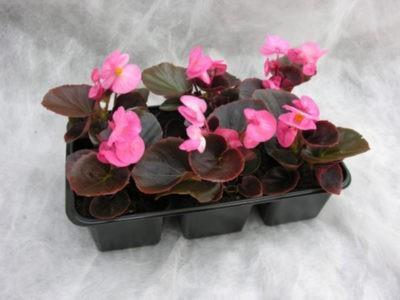

Refresh the cut on the handle that is in the water and change the water to clean water. You can add root roots to the water.- If roots do not appear in the soil, check if the soil is dry, cover the cutting to obtain high humidity.
- Check that all conditions of detention are being followed.
- Change the method of soaking in water to rooting in soil and vice versa.
- Take your time and give the plant time. If the roots appear in the water after a week and a half, then in the ground it may take 3-4 weeks.
What if a young plant does not develop?
- Check if all the conditions for the flower are provided.
- Examine the plant for diseases or pests. Diseases appear due to improper care and are treated with special drugs. Pests can be removed manually or by using systemic insecticides.
- Perhaps the plant is simply flooded with water. If the plant is really bad, you need to carefully remove the earthen lump and leave to dry. You can replace the soil and cut off rotten roots. Then you need to return the begonia to the pot.
- If development stopped in winter, there is nothing wrong with that, with the onset of spring it will continue to grow.
- For recovery, begonias can be transplanted outside in the summer. The main thing is that the landing site is protected from strong winds, showers and the scorching sun.
Possible diseases
- The leaves on the handle turned yellow and fell off.
There is nothing wrong with that, this is a natural process. If the plant takes root safely, it will definitely release new foliage. - Rotting cuttings.
This phenomenon is possible with excessive watering. Also, do not forget about the daily airing of the "greenhouses" in which the rooting of the plant is carried out. - A young ampelous begonia shows signs of infectious diseases.
To prevent this phenomenon, it is recommended to disinfect the soil, the pot in which the cuttings will be planted (treatment with fungicides, heat treatment). If, nevertheless, the plant is "sick", then it must be treated with special preparations, necessarily having previously isolated it from healthy plants in a well-ventilated room. - The sprouts stretch out, become long and thin.
The plant lacks light. You can solve this problem by rearranging the pot with young begonia in a brighter place. - Slow development of a young plant.
Most likely, the shoots lack nutrients. The solution is to fertilize the soil.
You can learn more about why tuberous begonia does not bloom and what to do, as well as what diseases can destroy a flower, can be found here.
Tuberous begonia is considered the most unpretentious species among begonias. And the process of grafting this plant will not take a long time for the grower and will not require his large material and energy costs. But the result will surpass all expectations: the personal plot will be decorated with lush flowering of not one, but several plants.
What to do and how to get the plant to give flowers?
Begonia is a plant that will never bloom if flower growers have not created all the conditions for a dormant period. She does not like to be "woken up" ahead of time.
On a note. You cannot move the pot from place to place when she has gained color.
Experienced growers are reviewing plant care in the absence of an ovary. They pay attention to:
- lighting;
- temperature;
- watering (you will learn how and what to water begonia in this article);
- air humidity.
Sometimes all the parameters from the list above are met. In this case, the problem is deeper - when replanting, the soil is selected at random. They get a non-nutritious soil. The soil should be loose and nutritious. Transplanting into a mixture of sand, peat, humus, turf and leafy soil helps restore flowering.
Incorrect identification of the type of plant and too "young" age
As already mentioned, begonias are flowering and decorative. If everything is clear with flowering varieties, then decorative begonias will delight the eye only with unusual leaves. Deciduous varieties are also very beautiful, but if begonia of a decorative type has got into the collection of flowers, it is useless to expect flowering from it.


Experienced flower growers have long noticed that begonia blooms on its own only after the formation of at least 5 rings on the main stem. When buying a young small plant that already has inflorescences, one can suspect that the flowering is caused artificially by the introduction of special stimulating drugs. This means that it will be short and will not be repeated until the begonia reaches the required age.
Gallery: begonia (25 photos)
Air humidity
In natural habitat, begonias do not suffer from a lack of moisture, because grow in the tropics or subtropics. When growing in an apartment, this should be taken into account, if possible, monitor the maintenance of a high level of humidity. However, be careful when spraying the leaves; water droplets on their surface can cause brown stains.


The best option would be to place the flower pot on an inverted pallet, which is installed in another one, larger in size and filled with expanded clay. Expanded clay is well moisturized, gradual evaporation of water will provide a comfortable environment for the plant humidity.
Rhizome division
Reproduction of bush begonias can be carried out by dividing the rhizome.
To do this, the bush is removed from the pot, too long stems, peduncles, leaves are cut off. The roots are washed in water to cleanse the soil.
With a sharp knife, the rhizome is cut into pieces so that each of them has at least one kidney. The slices are sprinkled with crushed charcoal.
The roots are processed with Kornevin or Heteroauxin for better rooting. Delenki are planted in individual pots and watered.
Reasons for the absence of buds
In the vast majority of cases, there is no budding due to improper care.
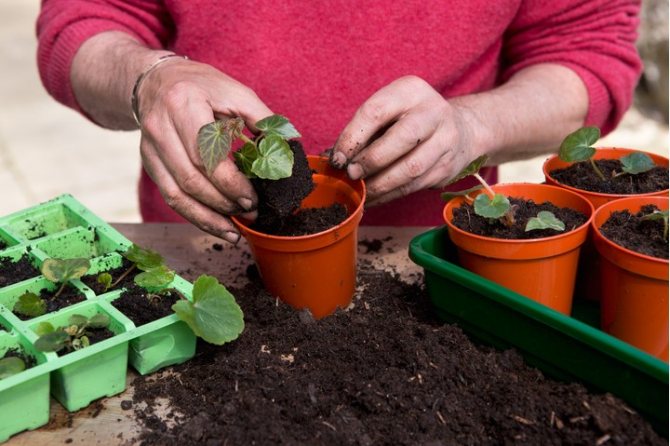

The bush may be missing:
- the amount of sunlight;
- introduced moisture;
- micro and macro elements in the soil.
Overly applied fertilizers can affect this, especially if the begonia was fed with nitrogen, and it is an ornamental deciduous species.
It should also be borne in mind that any stressful situation will cause the flower to weaken.In this case, he simply does not have the strength to release the buds and open them.
Tips from experienced florists for further cultivation
After the begonias have been multiplied, some rules must be followed.
- When planting cuttings in permanent pots, it is necessary to deepen them. Because young seedlings have weak roots;
- During watering, drops of water should not fall on the leaves. Plants cannot stand it;
- Begin to feed begonias 2-3 weeks after they are planted.
Begonias can reproduce in many ways. A flower grower should choose which method he likes best and soon begonia will bloom on his window!
Flower pests of begonias
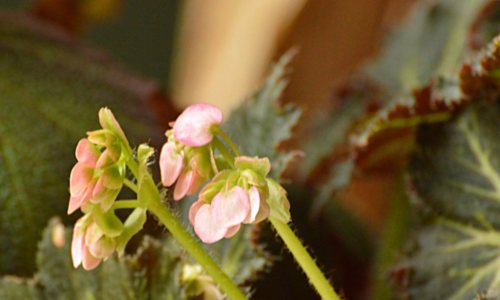

The defeat of a houseplant by flower pests can cause the lack of flowering. The vegetation of a tropical bush is disrupted, since all types of pests feed on the juice or begonia tissue. A careful examination of the leaves and petioles allows one to establish that the specimen has been attacked by pests.
Most often begonias affect:
- Aphid;
- Spider mite.
Aphids live on the lower part of the leaf plates and look like a slight raid to the naked eye. Microscopic insects of light green or whitish color can be seen under a magnifying glass.
Thin cobwebs in the area of the lower part of the leaves may indicate the presence of a spider mite. It is recommended to carefully remove the affected parts of the plant, and then carry out preventive treatment of begonias. The problem is solved through the use of insecticides. Chemicals are sold by specialized outlets. The aerial part of the plant is treated according to the instructions on the package. You should remember about personal safety.


Sometimes the cause of the death of a plant is soil infected with nematodes. Rehabilitation of the affected specimen is almost impossible. Nematodes belong to the class of protozoa. Experienced flower growers recommend getting rid of the soil along with the specimen and the flowerpot.
Recommendations
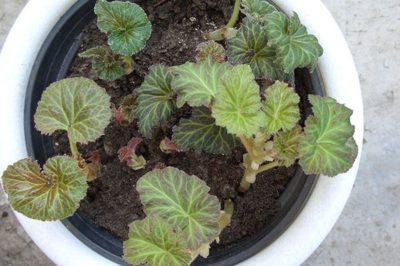

The plant in a flowerpot should be watered in moderation so that liquid does not stand on top of the soil.- It is recommended to water every day at the same time, preferably in the morning. The frequency of watering directly depends on the temperature in the room.
- In case of heat, abundant watering is necessary, otherwise the leaves will begin to fade. If the soil is completely dry, soak the pot in water for a couple of hours.
- In the winter season, water only when the ground in the flowerpot dries up. It is better to moisten the soil at this time with warm water. The plant is in a state of sleep, excess moisture is useless.
- After watering, be sure to loosen the top layer to saturate the soil with oxygen. A depth of 1 cm will be sufficient.
- During the setting of buds and flowering, begonia gives all its power to the inflorescences. This is when the watering should be generous. At the end of flowering, water in the same way.
- For the irrigation process, the immersion method is used. To do this, you need a container with a liquid in a volume larger than a flowerpot. We lower the begonia into it and leave it for a while, until the soil is saturated with water through the drainage holes.
What should be the soil
This is not to say that begonias tubers are very demanding on soil properties. The main thing is that the soil is fertile, neutral acid reaction and loose structure. For self-cooking, you need a ratio of 2/1/1/1 from:
- turf;
- vegetable humus;
- peat;
- medium-sized sand.
In order for begonia to grow and reproduce normally, a similar composition can be purchased at the store. If one is not available, a universal soil mixture for flowering plants is also suitable.
To grow an annual plant indoors, you should take care of a good drainage layer in the pot.
Begonia - planting and care in the open field
There are garden begonias, which can be taken care of in an open area.They are planted in a permanent place in the spring with the onset of warm weather. Plants are often germinated at home or in a greenhouse, and already grown bushes with flowers are placed in the garden. The site should be bright, protected from winds and direct sun. Large bushes coexist well with each other at a planting distance of 30 cm. When growing begonias, care in the open field consists in proper planting, watering, feeding the plant, and organizing a rest period for it.
Begonia - planting in open ground
Growing begonias outdoors begins with planting them in the garden. Ash and humus are poured at the bottom of the hole, and the bush is mulched with the same mixture after planting. How to care for begonia outdoors:
- After planting, watering becomes an important part of care - once every 3 days, in the heat it is possible more often. Moisten the bushes under the root carefully so as not to break fragile shoots. Water droplets should not fall on the foliage, so as not to cause sunburn.
- Begonia blooms from late May to October, its wilted flowers are removed.
- Fertilizer under the bush is applied 2 times a month. The optimal solution is a universal mixture for flowering plants. Young bushes require additional feeding based on potassium and phosphorus. You can sprinkle compost and peat on the flower beds.
- In autumn, watering is reduced, when there is no foliage left at all on the branches, they stop altogether. The ground part of the plant is cut off, leaving 3 cm sprouts. The tubers are dug up after 2 weeks and left to dry in a dry room. When the nodules dry out, they are cleaned from the ground and placed in a vessel with peat or moss. The container is stored in a refrigerator or basement.
Begonia diseases
Sometimes, with illiterate care, you can face such problems as diseases and pests of begonia:
- Often, begonia is affected by fungal ailments, powdery mildew and gray rot. In the first case, plaque spots appear on the plant, gradually covering all the leaves. In the second, watery glades are visible on foliage, flowers and shoots, growing into rot. These ailments are associated with excessive moisture. If problems are found, it is necessary to reduce the watering of the plant, spray it with fungicides such as Topaz, Fundazol, Bordeaux liquid or copper sulfate solution.
- The main pests of begonia are red spider mites and aphids. To combat them, Fitoverm, Karbofos, Intavir are used. The leaves are generously sprayed with insecticide, covered with cellophane.
Reproduction of tuberous begonia.
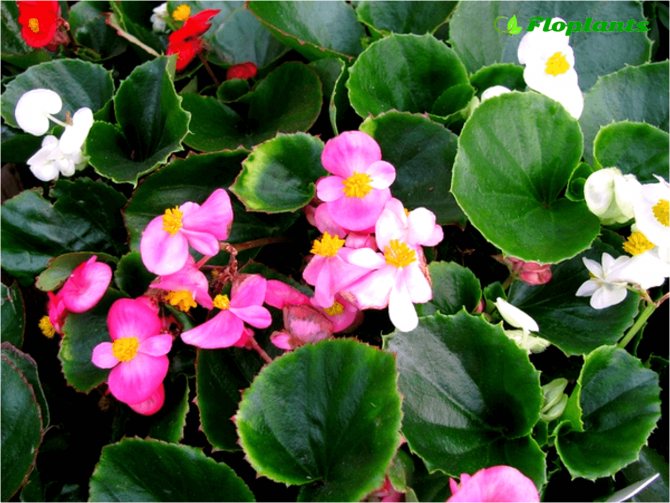

Begonia semperflorens.
Reproduction is carried out in early autumn, at the end of August. Begonia is removed from the ground, the tubers are buried in the sand for the whole winter. During the entire rest period, they are moistened several times so that they do not dry out and wither. In the spring, the tubers are removed from the sand and examined. Large tubers with a large number of buds are selected for division, while those that have hatched are not suitable for reproduction. The division of the tuber is carried out using a sharp knife. When dividing, you need to pay attention to the number of buds that you leave on the parts of the tuber - there should be at least two of them on each part. After dividing, the sections must be processed with crushed activated charcoal or charcoal, it is possible with ash. The treatment will prevent the growth of bacteria and the development of rot on the tubers.
The planting is carried out in a special substrate for begonias. Parts of the tubers are planted so that the buds rise slightly above the ground, after which they are watered and covered with a greenhouse until the first shoots appear. The tubers are completely covered with earth when the sprouts reach 5-7 cm.
You can read about the features of tuberous begonia here.
Views: 189
Variety of varieties
Decoratively bright and varied tuberous begonia is represented by many varieties with different types, shapes and color of flowers.
Non stop grade
Royal variety with flowers over 10 cm in diameter.Each individual flower is a terry collection of petals in a large bright bud, of which there are quite a few on a small plant only 20-30 cm.
The flowers of this variety are of an unusual kind - they are two-colored. The variety itself is represented by 12 different hybrids of white, yellow, pink, apricot and red.
Non-stop begonia grows in the form of a bush with well-developed horizontal branches, the length of which is easily adjustable. Thanks to this, it is recommended for decorating various landscape compositions.
Odorant grade
Begonia Odorata is in the form of a herbaceous bush with spreading branches about 20 cm high.It has large double inflorescences with white-pink buds up to 9 cm in diameter.
Flowering time June-October. Well suited for interior decoration, as well as a garden or balcony.
Variety of Grandiflora
The plant is small, covered with a large number of multicolored pink-shaped large flowers (diameter reaches 20 cm).
The petals can be smooth or double, which creates additional volume for the buds.
Pruning
Pruning is carried out primarily to rejuvenate the plant., removing old and dry shoots to form the crown and provide the begonias with a symmetrical attractive appearance, as well as to improve its flowering. Regular pruning helps maintain the correct ratio between root system and crown.
If the plant is grown from a small one, then the first pruning is carried out when its height reaches 7-8 centimeters. At this time, the owner decides what shape he would like to give to his pet and, in accordance with this, carries out pruning.
When pruning, the plant variety should also be taken into account, for example, the royal rex, along with all its hybrids, does not need to be cut off at all, and the tops of the ampelous ones should be cut often and regularly to stimulate lateral growth. Pruning begonias in spring is appropriate for bush varieties, they should be cut strongly, after which they have active growth.
Important! After the end of flowering, all pedicels should be removed so as not to deplete the plant.
Can you get begonias from seeds?
Of all the propagation methods for this plant, the least likely to get a good result will be when using seeds. Moreover, not every begonia can produce material that is suitable for further planting. This method is mainly used where plants of this type are grown for sale in large quantities.
First, the seeds must be sown in the ground. This procedure must be carried out in late autumn or in the middle of winter. If everything is done correctly, then after a year the begonia sprouts will be strong enough to develop normally. Sowing seeds is best in containers that can be closed. This will make it more likely that the plant will have enough moisture and heat.
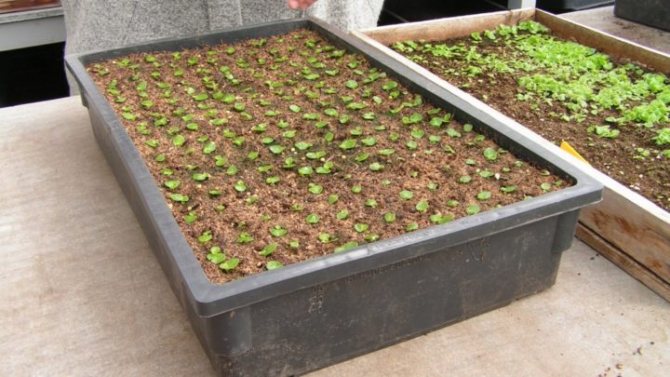

Growing from seeds
The seeds of this plant are very small. They are difficult to collect, and then it will be difficult to decompose in the ground. But manufacturers have found a way out. They offer pelleted begonia seeds that are coated with a special compound. This substance not only helps the seeds develop faster, but also increases their size, so the planting process is greatly simplified.
Before planting, it is imperative to prepare the soil. It should be a drainage substrate. It is important not to deepen the begonia seeds too much. Do not cover them with soil more than 0.5 cm. The soil should be shallow and loose. Any large lumps or stones can become an obstacle for the sprout.
Germination is carried out in a kind of greenhouse, where the air temperature must be high enough. It is desirable that this figure is above 25 ° C. In addition, it is necessary to maintain optimum humidity.To do this, the surface of the soil is sprayed every day with water from a spray bottle. With the right approach, the first shoots should appear in a couple of weeks.
Transfer
On a note. Young specimens are transplanted every six months, since with frequent changes, begonias begin to grow well.
Adult flowers are transplanted as the root system fills the container, usually once every 3-4 years.
A special the soil for the plant can be bought at the store, or you can make it yourself. To do this, you will need:
- Place regular sand drainage at the bottom of the pot.
- Cover half the pot with leafy soil.
- Add a one-to-one mixture of peat and black soil.
Below you can see a photo of how a flower transplant is performed.
How to water: water preparation
Before you start watering begonias, you must first prepare the water. Tap water will not work; it has increased hardness. First you should pass the liquid through a filter or resort to simple boiling... Thus, the water will become softer, and at the same time, it will get rid of chlorine and impurities.
The process of filtering tap water is done in this way: 1 kg of peat should be dissolved in 10 liters of liquid. The water becomes soft and acidic.
We transplant correctly
Begonia is transplanted when the flowerpot becomes small, if the soil is in doubt, after overflow and to stimulate flowering. A tropical plant needs loose, breathable soil so that water doesn't stagnate and roots don't rot. The composition of the soil is difficult to choose on your own, especially for novice growers. Buy a better specialized substrate in the store. Moreover, each species needs its own soil - with a certain acidity.
What you need:
- drainage;
- priming;
- a pot with drainage holes and a tray.
Instructions
- Take a pot about 3 cm wider than the one in which the begonia is growing.
- Place drainage on the bottom. Layer - not less than 2 cm.
- Remove the plant from the old flowerpot. Gently remove the old soil from the roots.
- Install in a new pot, cover with store-bought substrate.
You can transplant begonias into universal soil for flowering crops or into a mixture for violets. A prerequisite is that the base must be peat. If you understand that the soil is not loose enough, use "leavening agents" - perlite or sphagnum moss. It is better not to get carried away with "baking powder": a couple of spoons are enough (be guided by the size of the flowerpot).
Buying begonias, things to look out for


Begonia Elatior
When choosing a flower to settle at home, a novice gardener should carefully consider some of the nuances. Indeed, when buying a sick plant, there is a high risk of death or infection of other green pets with harmful insects.
The correct purchase should be like this:
- The flower sits firmly in the shipping container. The plant is stable and does not hang out in the soil mixture.
- The soil in the container is clean, dry, free of foreign odors, and even more so, without mold or moss.
- The plant should look healthy, the leaves are firm and shiny (although this is often the case from the use of special products that give the foliage a glossy shine), without spots and wounds.
- There are no extraneous living creatures in the flower. Carefully check the leaves on the underside for bugs or cobwebs. Let's pay attention to the soil mixture: do not small insects flicker there.
Better to buy a plant with unopened buds... It happens that varietal ever-flowering begonia at home throws off all the beauty. It depends on many reasons: climate change, adaptation, and more. Experienced indoor plant lovers advise when buying a green pet with open buds, to cut off all the flowers, which will give begonias time to adapt. And then it will bloom again.
Care activities
Potted begonias must be properly cared for after purchase.First of all, you should follow these steps:
- Choose a place for the plant. If the flower was purchased in the fall or winter, then the pot with it should be placed on the east or west side. When buying begonias in spring or summer, it is advisable to put it on the windowsill on the north side.
- You should not often move the container with the plant from one place to another. It is important to find a suitable corner, it is good if it is protected from drafts.
- Begonia loves space, it is best to keep it separate from other plants.
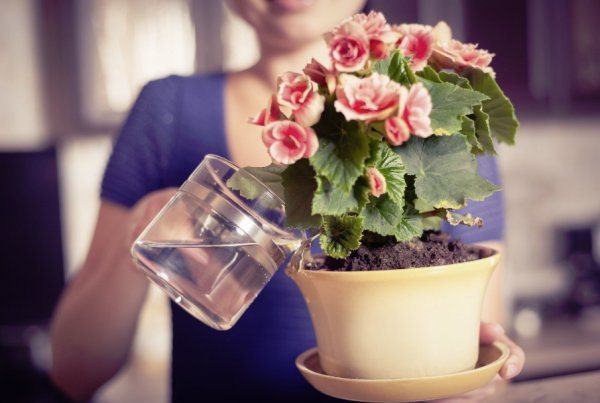

- After purchase, you cannot water the flower for 5 days. First, he must adapt to new conditions.
- Florists recommend refusing to transplant a plant immediately after purchasing it. This can be done if the soil does not inspire confidence.
- After purchase, the flower needs quarantine. Only after 2 weeks can you look for a permanent place for him. This is done in order to protect other flowers from potential diseases and pests.


Types of indoor begonias
The first mention of the begonia family dates back to the 17th century, when French travelers explored the island of Haiti. General Michel Begon was the governor of the island at the time. It was in his honor that the plant was named. This flower gained particular popularity about 200 years ago. Begonias have a total of over 1000 species. These include low-growing shrubs, dwarf shrubs and herbaceous plants. About 150 species are popular in decorative floriculture. However, in the entire history of the existence of this plant, breeders have bred so many hybrids that now no one will undertake to name their exact number.
Despite all the variety of forms, begonias have common species characteristics. They have fragile stems, leaves are juicy and fleshy, as a rule, asymmetric, pinnately dissected or whole, pubescent with fine hairs. The underside is reddish to dark purple in color, while the top can be one-color or variegated, including covered with multi-colored bizarre spots or patterns.
The inflorescence of begonia is a complex panicle, and there is an interesting feature: male and female flowers alternate on the pedicels. The latter can be recognized by the triangular seed capsule. This gives the plant an additional decorative effect.


Begonia inflorescence - complex panicle
It is customary to divide home begonia into 2 types:
- Decorative deciduous.
- Beautifully flowering.
Representatives of the first species cannot boast of bright colors, but the leaves of an unusual shape and varied color more than compensate for the absence of inflorescences. Often the largest specimens are found among them. For these begonias in pots or tubs, there should be enough room to allow room for the root system. With proper care, such a specimen can reach up to 1.5 m in height and become an independent part of the interior. The most striking representative of the decorative leafy begonia is the royal begonia. Its flowers are very inconspicuous and do not represent any decorative value, therefore it is better not to allow flowering, it can lead to depletion of the specimen.
We also recommend reading:
16 of the most popular indoor plants Physalis: description of species and varieties, technology of growing from spruce seeds in landscape design: the best decorative varieties and features of growing Kalanchoe: description of species and features of care at home
The second group is represented by flowering plants, and here those wishing to start breeding begonias will be able to satisfy their most demanding tastes. Small and large, simple and double, collected in inflorescences and single flowers differ in a variety of shades - from snow-white and pale pink to sunny yellow and crimson-scarlet. If you follow the correct regime of watering, feeding and lighting, this beauty can please the eye from spring to autumn.However, the ever-flowering begonia, widespread on many home windowsills, often justifies its name. Its pale pink inflorescences with small flowers often cover the carved leaves of the plant with a flowering carpet all year round.
Disease protection
Periodically, begonias suffer from fungal infections, most often caused by excessive moisture - gray mold and powdery mildew. The main symptoms are spots (gray-brown and white, respectively) appearing on the leaves.
Fungicides can help in the initial stages of the disease, but in more serious cases, it is better to get rid of the infected plants so that the rest of the flowers are not affected. Good prevention against diseases is the timely removal of yellowed leaves and dried begonia flowers.
Proper watering - how to organize it
Begonia loves high humidity, but watering should be organized in such a way that the ground is not too wet - begonias are prone to fungal diseases. As a preventive measure, irrigation with water with the addition of fungicides or manganese is used.
The plant experiences a special need for high-quality watering in summer, on hot days. But we must not forget. that your pet can suffer greatly from stagnant water in the pot, moreover, stagnation of water should not be allowed even in the pan of the pot.


It is not difficult to determine the optimal watering time - the soil after the previous moistening should dry out at least one and a half centimeters.
With the onset of winter, watering is done less often, tuberous varieties stop watering altogether. In winter, they begin a hibernation period, at this time it is recommended to place them in peat and take them out to a cool place.

